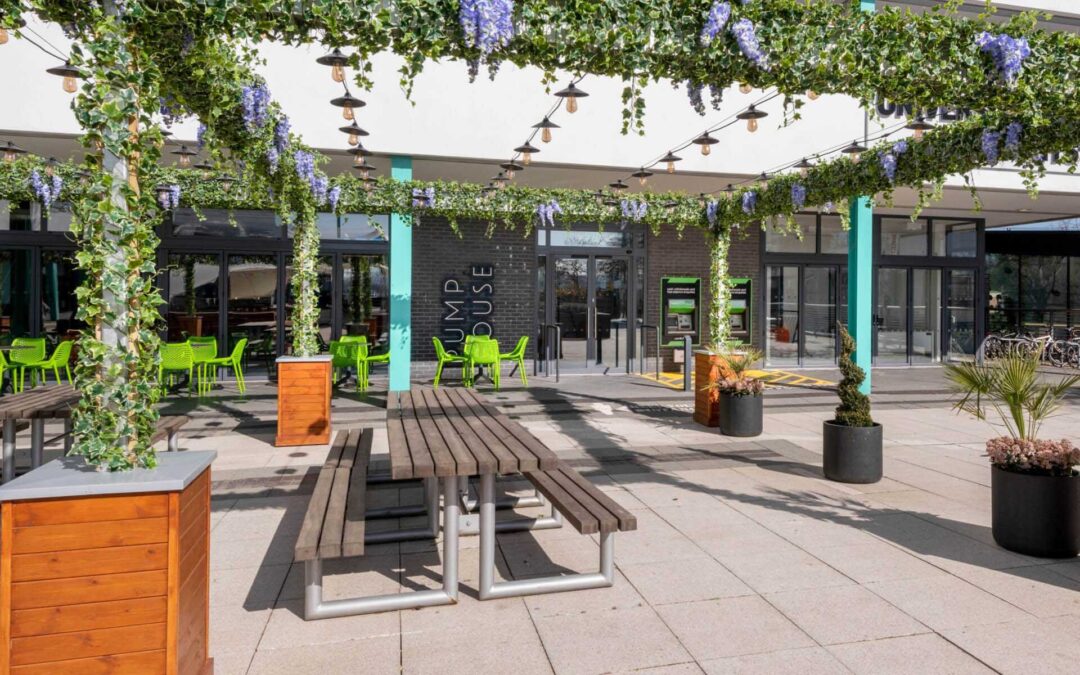With the new academic year now underway, a new academic year is arriving for UK independent schools. As school grounds and classrooms gear up to welcome students and teachers alike, it’s a pertinent moment to ponder: How we can craft environments that invigorate, foster creativity, and nurture well-being. The answer lies in biophilic design, a concept that seamlessly merges the human experience with the natural world. Imagine classrooms and corridors adorned with carefully selected, vibrant plants – a tapestry of greenery that seamlessly intertwines with the educational landscape.
Reconnecting with Nature
It is important to take a moment and reflect the significance of our connection with the natural world. Childhood memories often involve carefree days spent running across school fields, crafting daisy chains, or returning home with grass stains on our trousers. These outdoor experiences are interwoven with our formative years, shaping our connection with the natural world. This natural connection between humans and nature provides relief from stress, a sense of calm, and a boost to mental well-being. However, in our increasingly urbanised world, integrating nature into educational spaces has become a challenge.
Understanding Biophilic Design
Biophilic design, a term sometimes tossed around as a trend, actually carries incredible potential. Essentially, it harnesses nature’s influence to enhance human-created environments, and the outcomes can be truly remarkable.
The concept of biophilia, or the “innate tendency to focus on life and lifelike processes,” was first introduced by biologist Edward O. Wilson in 1984. This deep-seated connection between humans and nature has a rich history, dating back to the Greeks, who coined the term from “bios” (life) and “philia” (fondness). How can you incorporate this powerful concept into your school environment?
The Impact of Biophilic Design in Schools
The possibilities of incorporating biophilic design are vast – it will enhance attention spans, alleviate stress, and establish an ideal setting for effective learning. In fact, a groundbreaking study carried out by Terrapin Bright Green, in collaboration with Morgan State University and The Salk Institute for Biological Studies, proves the incredible impact of biophilia.
In a comparison between biophilic classrooms and non-biophilic counterparts, the study found that 35% of students in the biophilic classrooms perceived their stress levels as high compared to a staggering 67% in the control group. Moreover, after seven months in the biophilic classrooms, 7.2% more students tested at grade level than their counterparts in traditional settings.
Incorporating Biophilic Design in Schools: The Role of Plants
When it comes to integrating biophilic design into educational spaces, the choice of plants is vital. These ten types of plants work exceptionally well in school environments:
- Spider Plant (Chlorophytum comosum): Spider plants are known for their air-purifying qualities, making them an excellent choice for classrooms. They’re low-maintenance and add a touch of green to any space.
- Snake Plant (Sansevieria trifasciata): Also known as the mother-in-law’s tongue, snake plants thrive with minimal light and are excellent for improving indoor air quality.
- Peace Lily (Spathiphyllum): Peace lilies are elegant, low-maintenance plants that remove toxins from the air, promoting a healthier classroom environment.
- Rubber Plant (Ficus elastica): With glossy leaves, the rubber plant is an attractive addition to school interiors.
- Pothos (Epipremnum aureum): Pothos vines are versatile and can be hung in baskets or placed on shelves, enhancing the aesthetic appeal of classrooms.
- Fiddle Leaf Fig (Ficus lyrata): Fiddle leaf figs are known for their large, dramatic leaves, making them ideal focal points in school spaces. They thrive in bright, indirect light.
- Aloe Vera (Aloe barbadensis miller): Aloe vera plants are not only useful for soothing minor burns but also for improving air quality, perfect for science classrooms.
- Lavender (Lavandula): Lavender adds a pop of colour and a calming aroma, reducing stress and anxiety in students and teachers.
- Succulents: Succulents come in various shapes and sizes, adding a modern touch to classrooms while requiring minimal maintenance.
- Bamboo (Dracaena sanderiana): Bamboo is believed to bring good luck and prosperity. It’s a unique and visually appealing plant to include in your biophilic design.
Benefits of Incorporating Biophilic Design in UK Independent Schools
Adopting biophilic design in your school can bring a host of advantages and a positive influence on both students and educators:
- Enhanced Well-being: Biophilic design promotes emotional well-being and reduces stress, fostering a positive learning atmosphere.
- Improved Concentration: Students in biophilic classrooms often exhibit improved attention spans and better academic performance.
- Creativity and Innovation: Natural elements stimulate creativity and innovative thinking, essential skills for the future.
- Reduced Absenteeism: Cleaner air quality and a healthier environment leads to reduced absenteeism among students and staff.
- Sustainability Education: Biophilic design serves as an educational tool, teaching students the importance of sustainability and the environment.
- Positive School Image: Incorporating biophilic design enhances your school’s reputation, making it more attractive to prospective students and their parents.
Integrating biophilic design principles into educational spaces isn’t just a trend that will whizz by in the blink of an eye – it’s a potent tool that can significantly enhance students’ well-being, concentration, and overall learning journey. By establishing an educational setting that reconnects students with the beauty of the natural world, schools can nurture creativity, alleviate stress, and boost academic performance.
As the back-to-school season approaches, consider how you can incorporate biophilic design, along with carefully selected plants, into your school spaces. Witness your students thrive in an environment that wholeheartedly nurtures their growth and well-being, whilst promoting an environmentally conscious and caring approach to education.
If you are an Independent School Headteacher, Bursar or Estates Manager looking to transform your educational space into a thriving and creative environment where your students flourish, reach out to Exubia today.
Our team of qualified project consultants will help you throughout the process of implementing biophilic design and create an educational space for you, that inspires your students, resulting in a greener, healthier and more productive classroom environment.


Recent Comments